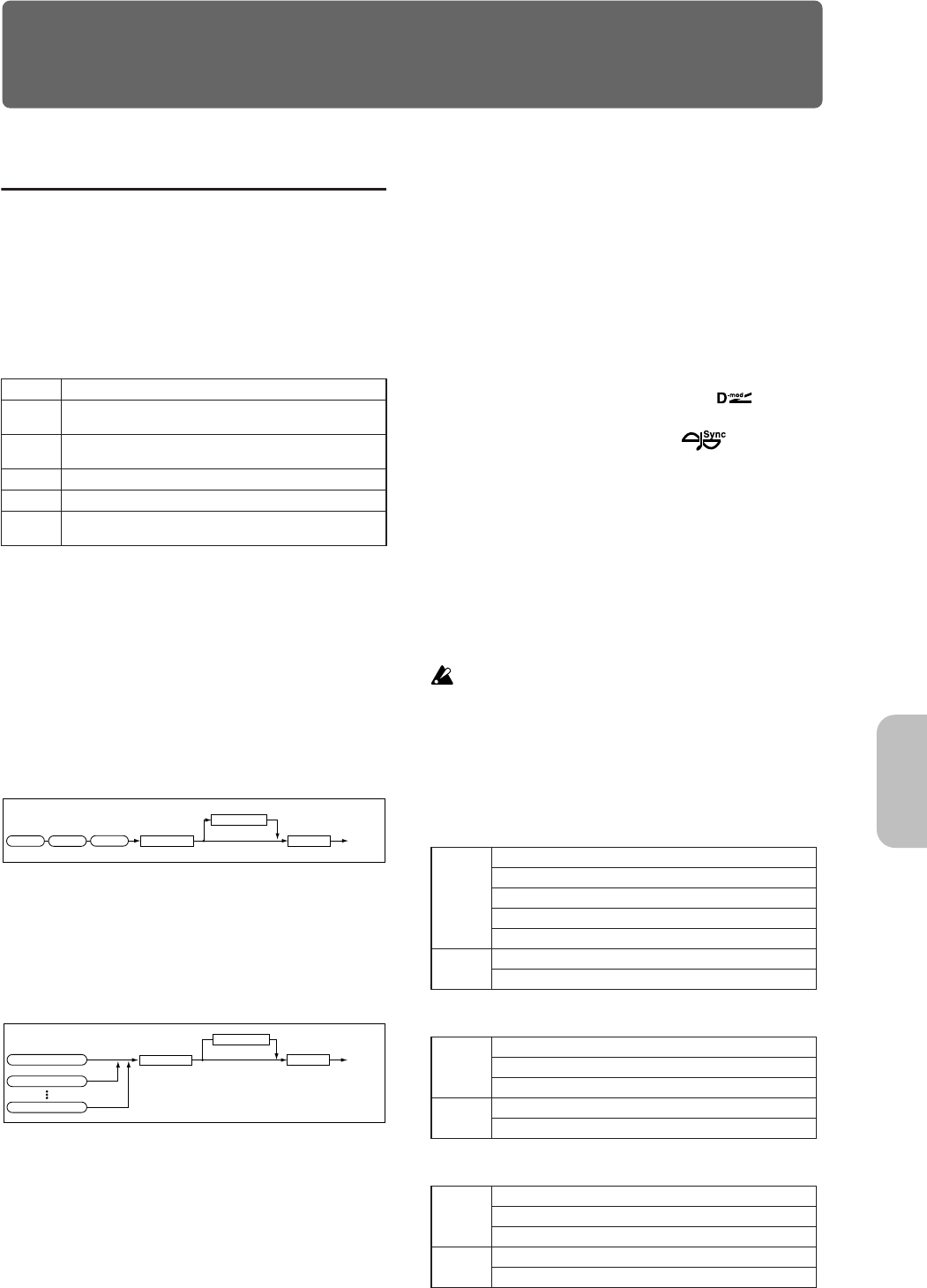
EFFECT
97
6. Effect Guide
Overview
The effects section of X50/microX consists of a single chan-
nel Insert Effect, two-channel Master Effects, a single-chan-
nel Master EQ (stereo, three-band EQ) and a Mixer section
that controls the effect routings.
The insert effect and master effects can be chosen from 89
types of full-digital effect, grouped into the categories listed
below.
Classification of 89 effects
1. Effects in each mode
In Program mode, you can process sounds using Insert
Effect. This is something like processing an oscillator (OSC)
output sound using a filter and an amplifier. Then, you can
apply a modulation and reverb effect or other Master Effect
to the processed sound to add ambience and space. Finally,
before the sound is output from the (MAIN OUTPUT) L/
MONO, and R connectors, you can fine-tune the tonal qual-
ity using the stereo, three-band Master EQ. You can adjust
these settings for each Program individually.
In Combination mode and Multi mode, you may process
Program sounds for each timbre and track using the Insert
Effect, add ambience and space to the entire sound using
the Master Effects, and adjust the overall tonal quality using
the Master EQ.
You can make these settings for each Combination in Com-
bination mode, and for each Multi set in Multi mode indi-
vidually.
2. Dynamic modulation (Dmod)
Dynamic modulation (Dmod) is a function that lets you use
the controllers of this instrument or MIDI messages to con-
trol specific effect parameters
*1
, allowing realtime control
while you play.
The BPM/MIDI Sync function
*2
is provided as another way
to control effect parameters. This allows parameters such as
the LFO speed of modulation-type effects or the delay time
of delay-type effects to be synchronized to the tempo of the
arpeggiator.
For details on these two functions, refer to “Dynamic Modu-
lation Source (Dmod)” (☞p.157).
*1
These effect parameters are marked with
(
☞p.104–).
*2
The effect parameters marked with support this
function (
☞p.108–).
3. Effect I/O
To achieve the best tonal quality, signals sent to the Insert
Effect and the Master Effects should be output at the maxi-
mum level without clipping. Also, use the “W/D” (wet/
dry) parameter for the Insert Effect and the “Output Level”
or “Rtn (Return1, 2)” parameter for the Master Effects to
adjust the effect output level.
This instrument does not have an input level meter that
monitors the input level of the effect. If the input level is
insufficient, the S/N (signal to noise) ratio will
decrease. If the input level is excessive, distortion may
occur.
The following table shows the parameters related to the
level settings:
Program mode
Combination mode
Multi mode
*1
:Some effects may not have these parameters.
00–15 Filters and dynamics effect, such as EQ and compression
16–31 Pitch modulation and phase modulation effects, such as cho-
rus and phaser
32–40 Other modulation and pitch-shifting effects, such as rotary
speaker and pitch shifter
41–51 Early reflection and delay effects
52–57 Reverb effects
58–89 Mono effects and mono chain effects, in which two mono
effects are internally connected in series
Insert Effect
Master EQ
Oscillator
Filter
Amplifier
ReturnSend
OUTPUT
L/MONO, R
Master Effect 1,2
Master EQ
ReturnSend
OUTPUT
L/MONO, R
Timbre 1 / Track 1
Timbre 2 / Track 2
Timbre 8 / Track 16
Insert Effect
Master Effect 1,2
Input OSC1/2 High, Low Level (PROG 1)
Filter1/2 Trim (PROG 4, 5)
Amp1/2 Level (PROG 6)
OSC1/2 Send1/2 (PROG 8)
Effect Trim parameter
*1
(PROG 8,9)
Output Effect W/D parameter (PROG 8, 9)
Rtn1/2 (Return1, 2) (PROG 9)
Input Volume (COMBI 0)
S1/2 (Send1/2) (COMBI 8)
Effect Trim parameter
*1
(COMBI 8, 9)
Output Effect W/D parameter (COMBI 8, 9)
Rtn1/2 (Return1, 2) (COMBI 9)
Input Volume (MULTI 0)
S1/2 (Send1/2) (MULTI 8)
Effect Trim parameter
*1
(MULTI 8, 9)
Output Effect W/D parameter (MULTI 8, 9)
Rtn1/2 (Return1. 2) (MULTI 9)


















